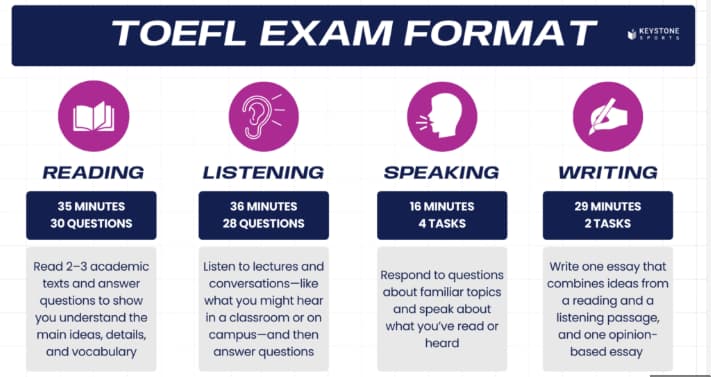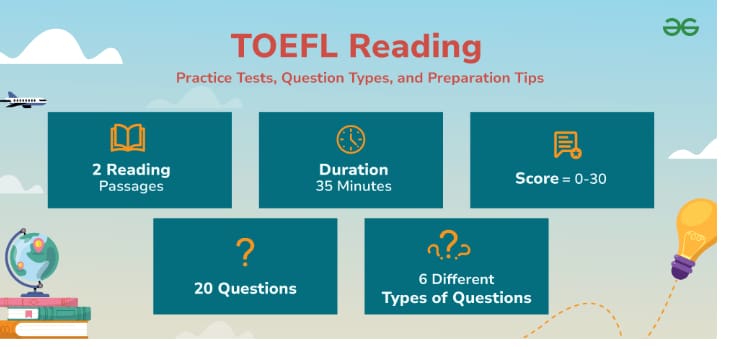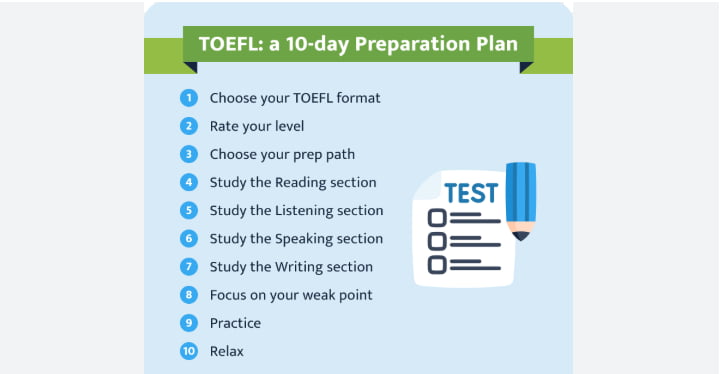Contents
Do you dream of studying at a university abroad, working for an international company, or simply proving your English at an academic level? Then it is quite possible that your path will cross with TOEFL (Test of English as a Foreign Language) at some point. When it comes to TOEFL tips and preparation, challenging reading passages, fast-talking professors, and stressful moments such as not knowing what to say after the famous “beep” sound immediately come to mind. But fear not!
Successful exam preparation starts with a clear determination of the target score. Then, it is necessary to create a regular study plan, use quality resources, solve sample questions, and take frequent mock exams. Time management, in particular, is a critical factor in getting a high TOEFL score, as completing all sections efficiently within the exam period can be quite challenging.

The TOEFL tips and preparation process can be made more efficient not only with individual study, but also with guidance and the right strategy. In this article, we will discuss in detail what to pay attention to when preparing for the TOEFL exam, the most effective resources, common mistakes, and tips for each section. Are you ready to get a comprehensive primer that will guide you through this exam journey?
In this article, we will transform the famous exam from a monster into a target that you can defeat with the right strategies. We will examine each of the four sections (Reading, Listening, Speaking, Writing) of this exam, where knowing English is not enough, but your ability to actively use this language is measured, and we will share the most practical tactics that will work for you for each one.

Reading Section: Don’t Get Lost in the Texts While Racing Against Time!
The TOEFL Reading section presents you with 3-4 long, academic texts and asks you to answer questions about them. The topics can range from biology to art, history to astronomy. Your biggest enemy here is the obsession with understanding everything word by word, and of course, time! Your goal is not to master every detail of the text, but to extract the information from the text that will answer the questions asked in the fastest and most accurate way. That’s why you have to read strategically.
Start by “skimming” the text quickly before reading it. Take about 1-2 minutes to look at the title, subheadings, and the first sentence of each paragraph. This will give you invaluable background information about what the text is about and how it is structured. Grasping the main idea and general flow of the text from the beginning will prevent you from getting lost in detailed questions later. It’s like looking at a map of a city quickly before going there.
Once you have a general idea, instead of reading the entire text, go straight to the questions. In TOEFL tips and preparation, reading questions usually follow the order in the text. The first question is at the beginning of the text, and the last question is at the end. Read the question, guess where the answer to the question may be in the text, and read only that section carefully. This “target-oriented” reading technique is one of the methods that will save you the most time.

Extract the Meaning of Words from Sentences!
You will come across words you do not know, it is inevitable! Don’t panic. TOEFL does not measure whether you are a dictionary or not, but whether you can deduce the meaning of a word by looking at the context in which it is used. Especially in “vocabulary” questions, check whether the sentence makes sense by replacing the word you do not know with the words in the options. Most of the time, the general flow of the sentence will whisper the right word to you.
Finally, be prepared for the summary questions, which are the most challenging but also the most rewarding. In these questions, you are asked to find 3 options that summarize the main ideas of the text. Remember, the key word is “main idea“. Small details, examples or statistics in the text are usually the wrong options. This is where the quick “skimming” technique you did at the beginning comes into play. The main ideas you catch in the first sentences of the paragraphs will guide you in solving this question. This topic is very important for TOEFL tips and preparation.

Listening Section: The Art of Taking Notes and Catching Hidden Clues
Here we come to another section that many candidates have difficulty with during TOEFL tips and preparation process: Listening. In this section, you will listen to lectures from university classes and conversations about campus life.
- The biggest challenge is that you can only listen to each recording once! Therefore, instead of being a passive listener, you have to actively take notes while listening. Taking notes is not a choice in this section, but the key to success.
- Effective note-taking does not mean trying to write down every word you hear. This is impossible and distracts you. Instead, use abbreviations, symbols, and keywords. For example, instead of “increase,” you can write an up arrow (↑), and instead of “because,” you can write “b/c.” If you are listening to a dialogue, you can divide your paper in half and take notes of what each speaker says in separate columns.
- If you are listening to a lecture, you can draw a simple mind map showing the main ideas and supporting examples. The important thing is to develop a fast and effective system that you will understand.
- Listen for signposts while listening. Speakers are constantly giving clues to help the listener follow the topic. Expressions like “The most important reason is…”, “Let’s look at two examples…”, “In contrast to this theory…” are a sign that important information is coming. Also, changes in the speaker’s tone of voice (emphasis, surprise, doubt) are often hidden clues that you will encounter in questions.

TOEFL Tips: TED Talks and Possible Questions
When listening, focus not only on the information but also on possible questions that may be asked. TOEFL Listening questions are usually clear: What is the main purpose of the speech? What does the speaker think about this topic? Why was this example given? What was a particular detail? Knowing these types of questions will help you predict when a professor is explaining a topic, and you can take more careful notes accordingly.
Don’t just stick to TOEFL tips materials to familiarize yourself with different accents and speaking speeds. Watch TED Talks, listen to podcasts in English about your interests, and find lecture recordings from popular universities on YouTube. These types of real-life materials will both improve your listening skills and equip you with vocabulary on different topics. This is a great way to make the preparation process more enjoyable.
Speaking Section: Turn Those 15 Seconds of Prep Time Into Gold!
The Speaking section is where many candidates get the most stressed. Because you are not facing a human, but a computer, and it only gives you 15-20 seconds of preparation and 45-60 seconds of speaking time to answer a question. The aim here is not to speak perfectly and without mistakes; it is to be able to express your ideas in a clear, fluent and coherent manner in a certain amount of time. In other words, presentation is as important as content.
- The secret to this section is to use a template. Having a ready-made structure in mind for each question type (Independent and Integrated) in TOEFL tips and preparation process allows you to focus on “how to say it” instead of thinking about what to say in that short preparation time. For example, for a personal preference question, a template like “Personally, I prefer… for a couple of reasons. First of all,… For instance,… Secondly,… That’s why…” makes it incredibly easy to organize your thoughts. Memorize these templates and practice a lot.
- Practicing with a timer is a non-negotiable rule. Always, always, work with a stopwatch. Turn on your phone’s voice recorder, prepare for 15 seconds, and speak for 45 seconds. Then listen to your recording. Are you talking too fast? Are you using too many filler words like “Eee” and “ııı”? Are your transitions between ideas clear? Hearing your own mistakes is the most effective way to correct them.

Integrated Tasks and Natural Flow
Focus on clarity and natural flow during your speech. Saying less and expressing it clearly and understandably is much more important than trying to say a lot at an incredible speed. Add emotion to your speech by using stress and intonation, and avoid a monotonous voice. A confident tone of voice will also make your content more perceivable. It is one of the most important TOEFL tips for preparation.
In integrated tasks where you have to summarize reading and listening texts, the quality of your speech depends entirely on the quality of your notes. During reading and listening, focus on taking notes of only the key information that you will use in the speech. What was the main idea of the reading text? What examples did the speaker use to support or refute this idea? Once you have captured these key points, it will be much easier to place this information in your template for the speaking section.
TOEFL Tips in Writing Section: Create an Impressive Essay Out of Your Ideas
Here we come to the last leg of the marathon for TOEFL tips: “Writing“. In this section, you will have two main tasks. The first is the Integrated Writing task, where you summarize the relationship between the two after reading a text and listening to a lecture. The second is the new Writing for an Academic Discussion task, where you participate in an online class discussion and express your own opinion. The most important thing in both tasks is to be able to present your ideas in a logical structure for TOEFL tips.
- Templates are a lifesaver in the Integrated Writing task. In your introduction paragraph, state the main idea of the reading text and how the professor in the listening session opposes (or supports) this idea. In each of the body paragraphs, address a point put forward by the professor; first explain what the professor says, then explain which point in the reading text this statement refutes and how. You do not need to write a conclusion paragraph. Your focus is to clearly show the relationship between the two sources.
- In the newly added Academic Discussion task, imagine yourself in an online forum. You are asked to contribute to a given discussion question and two other students’ comments. As a first step, clearly state your own unique opinion and support it with an argument. Your goal is to offer a new perspective that will move the discussion forward. Don’t be afraid to say, “I think…” This a new suject for also TOEFL tips.

Academic Statements and Quotations – Interactions
To be successful in this new task, it is not enough to just state your own opinion; for a successful TOEFL tips and preparation process, you also need to interact with other students’ comments. For example, you can agree with a comment and develop it by saying, “As John stated… in addition, we should also consider…” Or you can politely disagree and present your own reasoning by saying, “Although Maria’s approach is interesting, I have a different perspective because…” The important thing is to create a constructive and academic discussion environment.
In TOEFL tips subject, for both writing tasks, having a list of academic expressions at hand will make your job much easier. Expressions like “The author of the passage argues that…”, “On the other hand, the lecturer contends that…”, “To elaborate on this point…”, “While it is true that…, it is also important to consider…” will both give your writing a more professional tone and help you organize your thoughts. And of course, after you finish writing, make sure to spend the last 2-3 minutes reviewing what you wrote and correcting simple grammar and spelling errors!
This exam is a marathon that requires strategy, practice, and patience. By developing special tactics for each section, practicing regularly, and most importantly, believing in yourself, you can successfully complete this marathon. Remember, the TOEFL tips and preparation process is not just an exam, but also an important step that will help you achieve your dreams abroad. Now is the time to apply the tips in this guide and take the first step towards reaching that score you are aiming for. Good luck and success to you all in advance! (Please do not forget to read TOEFL vs IELTS!)
